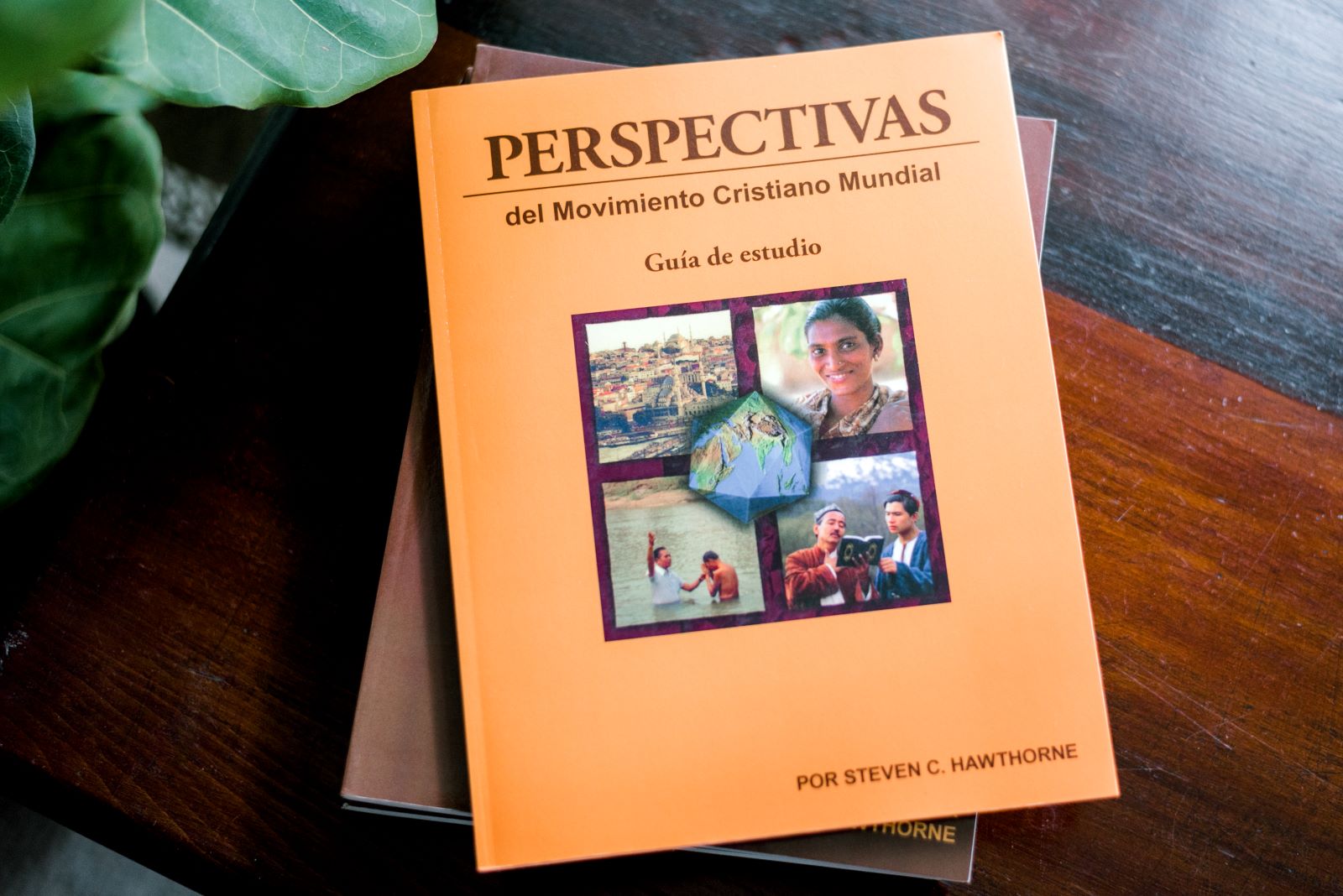Learn more about the
Perspectives is a fifteen-lesson discipleship course exploring different aspects of God’s global purpose in a multi-faceted learning experience. The course examines the story of God fulfilling His promises from four vantage points or “perspectives” — Biblical, Historical, Cultural, and Strategic. The Biblical and Historical sections establish the foundation of our confidence in the historic fact of God’s persistent work to make His name known to the nations from the dawn of history until today. The Cultural and Strategic sections highlight that we are in the midst of a costly but very “do-able” task. These sections confirm the Biblical and Historical hope we have with the invitation to co-labor with God in His mission.
Perspectives is an awe-inspiring comprehensive course that has profoundly impacted hundreds of thousands of students during the past 45+ years. From Genesis to the prophets, Jesus to the early Church, and St. Augustine to the present, students learn how God moves, how the global Church responds, and the remaining task of world evangelization. Perspectives isn’t a course solely about world missions. It’s a study program rooted in Scripture clarifying each believer’s remarkable opportunity to co-labor with God in His global purpose.
You have an integral role to play in God’s story. He delights when His people respond to His invitation to be a blessing to all the peoples of the earth. Experience God’s heart for the nations and encounter the momentum of the World Christian movement through Perspectives.
Perspectives is more than just a class. It is an experience that can reshape the trajectory of the rest of a person’s life. We have identified three components that God uses to create the Perspectives Class Experience




1
4
15
The Biblical section follows three interrelated thematic trajectories through the Bible: God’s blessing, glory, and kingdom. Tracking these themes enables us to see a coherent story that encompasses all the stories of the Bible.
Lesson 1 explores the expansive scope of a unified story that is shaped by God’s promise to fulfill a global purpose to bless all peoples. God Himself is acting with a global purpose—a mission. The living God is a missionary God.
Guided through Scripture, students learn that God’s three-fold global purpose is for people (bringing redemption and blessing), toward Himself (receiving global glory in worship), and against evil (showing kingdom victory over satanic powers). The extent of God’s promise and His passionate pursuit of His mission to bless people for His glory makes his invitation to co-labor with Him an extraordinary privilege.
Lesson 2 traces the unfolding story of God acting to reveal Himself to people of all nations. God’s desire for glory is more than recognition of greatness. He reveals Himself for a purpose. The global purpose of God in manifesting His glory is not simply to be known and not solely to save people. His driving purpose is relational—to love and be loved by people who give themselves to Him in whole-life worship. Worship—loving obedience to God—is paramount to making sense of the entire story of God’s glory.
Lesson 3 explains the extraordinary price Jesus paid to reconcile people who were His enemies and the hope we have because of his Kingdom rule. God has always governed all things with sovereign authority—working against evil, overcoming the powers of darkness to redeem a unique people from all people groups. Students learn the anticipated kingdom is a dynamic authority rather than a program to erect an ideal society and that Christian hope is more than optimism. It is the confident expectancy that God will surely fulfill all that He has promised.
Jesus is the focus of Lesson 4. His commands, promises, covenants, and miracles constitute a decisive mandate that empowers the people of God to co-labor with Him to fulfill His global purpose. This lesson dismantles stereotypes of mission as a tedious duty for a few super-zealous saints. Jesus launched a global mission to reach all peoples that He is continuing and will certainly fulfill.
Lesson 5 explores how God launched and expanded the World Christian Movement. Initiated at the Jerusalem Council in Acts 15, God orchestrated events enabling the apostles to recognize that the gospel transcends Jewish religious identity and culture. This lesson examines the maturing of church planting movements through the Word and the Spirit and the Pauline principles that inform cross-cultural outreach to the present day. It considers how the suffering and persecution of God’s people often have a strategic role in advancing God’s global purpose.
The Historical section shows the continuity of God’s purpose from biblical times until the present day. This section is not merely recounting representative events of mission history. It presents a theology of history.
Lesson 6 provides a bird’s-eye view of the largest and longest-running movement in history—the World Christian Movement. Students learn how the momentum of God’s global purpose has been accelerating from the Council of Jerusalem in Acts 15 to the present. The gospel surges through the peoples and places of the world despite obstacles and disobedience are evidence that God’s promise must be fulfilled and what He has purposed will be accomplished. It’s an instructive overview that shows the reality of God’s declared promise being fulfilled in linear history and the impact and spread of the general blessings of the kingdom of God throughout the world.
In Lesson 7, students learn about the remarkable explosion of mission growth in the last 200 years, seen in three bursts of activity—each focused on advancing the gospel at the frontiers of the unevangelized world. Our present-day efforts of evangelizing unreached peoples could see the completion of God’s purpose for every people group. Today’s harvest force increasingly consists of non-Western missionaries and involves navigating socio-cultural differences.
Lesson 8 provides insight into present-day mission work by examining the faithfulness and wisdom of ordinary people who accomplished extraordinary things in earlier generations, including the significant contribution of women in missions. The writings of William Carey and other missional leaders reveal a symphony of diverse methodologies that empower leaders of the World Christian Movement. The only word that accurately describes these missional innovators is “pioneers.”
Lesson 9 focuses attention on the distinctive people groups of the earth. The concept of “unreached peoples” guides our assessment of the remaining task. God has been advancing His global purpose since Abraham to today—to “bless all peoples of the earth.” Lesson 9 examines how redeemed communities can open the way for transforming whole societies through God’s blessing. Co-laboring with Him to stand against evil enables the declaration of the Gospel of the Kingdom with clarity and power.
The Cultural section enables students to understand the complexity and feasibility of the gospel being conveyed well by cross-cultural messengers to bring about culturally appropriate Christ-following movements. This section helps students to understand how two things can flourish in their cultural context: the message and the messengers.
The complexity of culture enables the gospel to spread powerfully within a culture but also explains why it does not “jump” easily across cultural boundaries. Lesson 10 explores what culture is, how to understand it, and practices that facilitate the jump across barriers that have long obstructed the advance of the gospel among the least evangelized. Discovering redemptive analogies within a culture is often an avenue for communicating the gospel with relevance. Developing discernment to understand culture and worldview is essential to effective intercultural gospel communication.
Lesson 11 examines how reception as a credible messenger is vital for communicating the gospel and how Christ’s incarnation serves as a model of missionary humility. Since the Apostle Paul’s day, missionaries have been learning how effective relationships span cultural gaps—by building bridges of love. Entering appropriate roles to form relationships of trust enables us to communicate with credibility. Students will consider the fascinating possibilities of initiating gospel communication with strategic individuals with the highest potential to multiply followers of Jesus.
The Strategic section shows how the task of bringing about Christ-following movements in every people can actually be accomplished. The possibilities and complex issues of seeing vibrant church movements flourish in every people are analyzed and show how church movements bring forth God’s promise of transformational blessing among all peoples.
Lesson 12 investigates how Jesus’s Lordship, through Christian community development, provides hope for significant societal transformation and reconciliation between peoples. Students will consider some of the most critical dimensions of global human need and the nature of poverty. Transformational change happens at the community level when development efforts are integrated with church planting. This lesson dispels the stereotype of missionaries as cultural imperialists.
Lesson 13 clarifies that churches are defined not as institutions but as dynamic movements of Christ-followers. As organic, living things, churches can multiply rapidly and bear the fruit of social transformation. The presence of such movements defines what it means for a people group to be “reached.” Students will explore an example of how existing church movements can find fruit-bearing expressions amidst urban sub-groups and overlooked generations. Knowing that churches can bring forth the power and beauty of Christ gives us confidence that He will not fail to fulfill His promise to bless all the peoples of the earth and to fill the earth with Christ’s glory.
Lesson 14 investigates how to initiate the all-important beginning—the missiological breakthrough. The importance of contextualizing the message, messenger, and movement is examined and discussed. Breakthroughs are often aided by a “person of peace” and avoided when “extraction evangelism” and “conglomerate churches” are exchanged for people-group-specific efforts. This lesson clarifies why pioneer church planting among unreached people groups is necessary and challenging but feasible.
A cursory summary of the entire course, Lesson 15 reviews the grand unfolding story of Christ coming to be loved and glorified by a people drawn from all people groups. The four basic practices, the four essential disciplines of World Christians, and reasons for living a strategic lifestyle are discussed. Students will examine practical ways of pursuing God’s global purpose and how wise partnerships with local churches and Christians in different parts of the world enable the completion of the Great Commission. Living as a “World Christian” empowers you to live a genuine purpose-directed life.
The Key Reading Level is the introductory level of the course. You’ll receive the same instruction and participate in the same activities as the Certificate and Credit level. You will be required to read three to five Key Articles weekly and complete several Personal Responses.
*Alumni surveys indicate students who enroll at the Certificate or Credit Level benefit the most from the course.
Deepen your understanding of God’s global purpose through the recommended certificate readings and assignments. You’ll receive individualized feedback on your weekly Lesson Reviews, Personal Responses, and the Integrative Project. Students earn a Certificate of Completion from Perspectives USA – valued at churches and agencies. This is the recommended level for getting the full impact of the course.
You can receive college undergraduate or graduate-level credit for taking the Perspectives Course! You must verify that the credits from your choice of our partner credit institution qualify for transfer at your receiving college or university.
Copyright © Perspectives USA 2024. All rights Reserved. Perspectives on the World Christian Movement ®